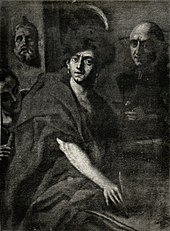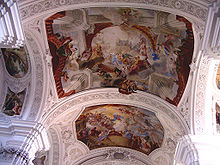Asam brothers


The Asam brothers , Cosmas Damian Asam (1686–1739) and Egid Quirin Asam (1692–1750), worked as sculptors , plasterers , painters and architects who worked separately, but mostly together, mainly in southern Germany. They are among the most important representatives of the German late baroque .
Life
Cosmas Damian Asam and his brother Egid Quirin were two of nine children of the monastery painter from Benediktbeuern , Hans Georg Asam . Both received training as painters from their father. After the death of their father in 1711, they decided to expand their field of activity to include stucco and architecture, so Cosmas Damian, supported by the Abbot of Tegernsee, traveled to Rome for further training . In 1713 Cosmas Damian received the first prize of his painting class in the Accademia di San Luca in the presence of the Pope . It is possible that his brother Egid accompanied him on this trip, although at that time he was training with the Munich court sculptor Andreas Faistenberger , which he successfully completed in 1716. After Cosmas returned from Italy, the brothers received numerous commissions thanks to their close ties to the Benedictine order .
Both brothers carried on the father's legacy with their passion and education. Cosmas Damian worked as a painter and sculptor, Egid Quirin as an architect, plasterer and sculptor. Since their main areas of work complemented each other well in construction, they worked together on almost all of their assignments.
Cosmas Damian's great talent for fresco painting in particular quickly made the brothers known beyond the Upper Palatinate . His frescoes were in demand and paid for in a similar way to those of the Italian contemporary Giovanni Battista Tiepolo .
While the frescoes and stucco work in Bamberg were still strongly influenced by illusionism, in later works such as in Weingarten they succeeded in creating a uniform interplay of individual elements that provided a stage-like setting for the baroque church service (the theatrum sacrum ). With the construction and design of the Weltenburg abbey church, they laid the foundation for their fame. In the spirit of the late baroque, they succeeded there in an impressive way in combining painting , sculpture , lighting , interior design and architecture into a unified total work of art.
In 1723/24 they created the frescoing and stuccoing of the Freising Cathedral in less than a year and a half and based their choice of colors for frescoes and stucco on the colors of the high altar painting by Peter Paul Rubens , so that the impression of the room leaves a harmonious overall picture.
Their building contracts ranged from Bohemia to Tyrol and Switzerland , from around 1727 both were based in Munich. Her most famous building is the church of Sankt Johann Nepomuk in Munich, next to her house. The late work was created in the smallest of spaces and without commission for the personal salvation of the Asam brothers.
student
Among the students of Cosmas Damian Asam are u. a. counted:
Works

in the frame with Asamhaus

- Frescoing of the dome of the former Ensdorf abbey church , 1714
- Dome fresco in the Trinity Church in Munich , 1714/1715
- Frescoing of the facade of the Claudi Cleer House in Kaufingerstrasse in Munich, 1715
- Frescoes in the Metten monastery church , 1715
- Side altar painting of the Guardian Angel Church (formerly the Franciscan Church) in Straubing , around 1710
- Frescoes in Bamberg , 1714
- Weltenburg Abbey Church , 1716/18, 1721, 1734/36
- Monastery church in Rohr in Lower Bavaria , 1717/23
- Pilgrimage Church of Maria Hilf im Amberg, 1717
- Michelfeld Monastery , from 1717
- Basilica of St. Martin of Weingarten Abbey , 1719
- St. Korbinian Chapel on Weihenstephaner Berg in Freising , 1720, demolished in 1803
- Aldersbach Monastery , 1720
- Schleissheim Palace , 1721
- Frescoes in the St. Anna Chapel in Kißlegg
- St. Jakob Cathedral in Innsbruck , 1722/23
- Cathedral of St. Maria and St. Korbinian in Freising , 1723/24
- Einsiedeln Monastery Church , 1724–1726
- Holy Spirit Church in Munich , 1727
- Břevnov Monastery (Breunau) near Prague, 1727
- Bruchsal Castle Church , 1728 (destroyed in 1945)
- Draft for the grace altar of the pilgrimage church of the Assumption in Dorfen , 1728 (executed 1740/49, demolished in 1868, reconstruction in 1971)
- St. Anna im Lehel monastery church in Munich, 1729
- St. Anna Gotteszell Monastery Church , 1729
- Jesuit Church (Mannheim) , 1729–1731
- Alteglofsheim Castle (today the Bavarian Music Academy), 1730
- St. Emmeram Monastery in Regensburg , 1731–1733
- Altenmarkt-Osterhofen Monastery Church , 1732
- Ettlingen Palace Chapel , 1732
- Monastery church in Legnickie Pole (Wahlstatt) in Lower Silesia , 1733
- Asamhaus , Sendlinger Strasse 34 in Munich, 1734
- St. Johann Nepomuk ("Asamkirche") in Munich, 1734
- Augustinian Church in Regensburg , 1734
- Castle chapel St. Anna in Maxhütte-Haidhof - Pirkensee, 1734
- Old country house in Innsbruck, 1734
- St. Anna's Collegiate Church in Munich, 1735
- Altars of the Sandizell Castle Church near Schrobenhausen, 1735
- Ursuline Church for the Immaculate Conception of Mary in Straubing, 1736–1739 (last joint work of the brothers)
- Maria de Victoria in Ingolstadt , 1736
- Johanni Chapel in Freising Cathedral , 1737/38
- Fürstenfeld Monastery , 1741

- Bischöfliches Palais Eichstätt , painting The Last Supper, 1st half of the 18th century
- Catholic Church of St. Martin in Meßkirch / Baden, Nepomuk Chapel
literature
- Bruno Bushart et al. (Ed.): Cosmas Damian Asam (1686–1739). Life and work . Prestel, Munich 1986, ISBN 3-7913-0767-3 .
- Frank Büttner: Cosmas Damian and Egid Quirin Asam . In: Katharina Weigand (ed.): Great figures of Bavarian history . Herbert Utz Verlag, Munich 2011, ISBN 978-3-8316-0949-9 .
- Anne Dreesbach: Cosmas Damian Asam and Egid (Aegid) Quirin Asam . In: Jürgen Wurst, Alexander Langheiter (Ed.): Monachia . Städtische Galerie im Lenbachhaus, Munich 2005, ISBN 3-88645-156-9 , pp. 102-103.
- Gabriele Greindl: The Asam brothers. Baroque in Eastern Bavaria . HB, Hamburg 1986, ISBN 3-616-06722-7 .
- Gerhard Hojer: Cosmas Damian and Egid Quirin Asam . Munich 1986.
- Anton Röhrl: The Asam family of artists and their work in Lower Bavaria and the Upper Palatinate . Weltenburg Academy, Abensberg 1987.
- Bernhard Rupprecht: The Asam brothers. Sense and sensuality in the Bavarian baroque . 2nd Edition. Regensburg 1985, ISBN 3-7917-0653-5 .
- Klemens Unger: The Asam brothers. Baroque in Eastern Bavaria and Bohemia . Schnell & Steiner, Regensburg 2000, ISBN 3-7954-1261-7 .
- Asam in Freising. Catalog for the exhibition in the Diözesanmuseum Freising November 24, 2007–3. February 2008 . Diözesanmuseum Freising, catalogs and writings, 45. Schnell & Steiner, Regensburg 2007, ISBN 978-3-7954-2034-5 .
- Erika Hanfstaengl: Cosmas Damian Asam. Filser, Munich 1939 (= Munich Contributions to Art History 4).
- Philipp Maria Halm: The Asam family of artists. Lentner, Munich 1896 digitized



